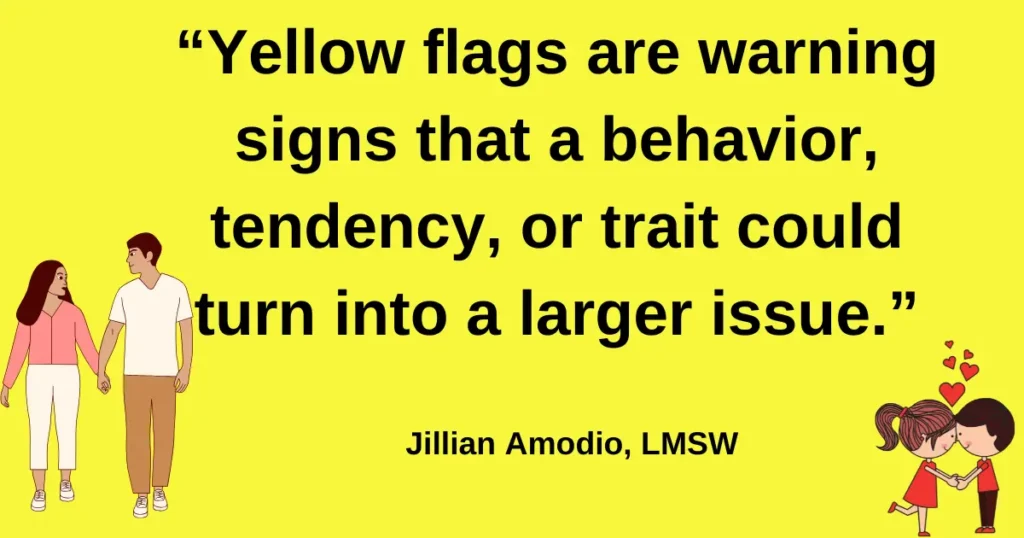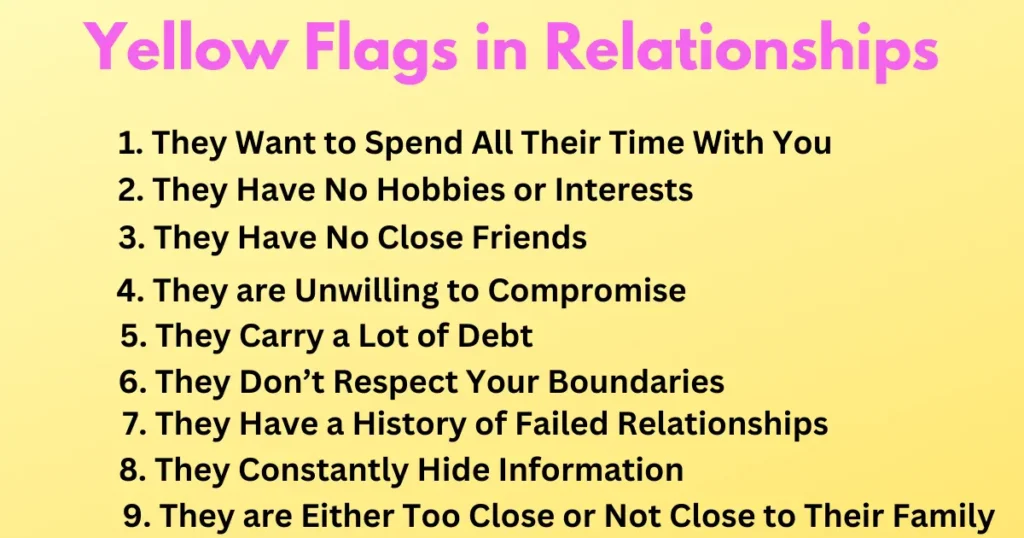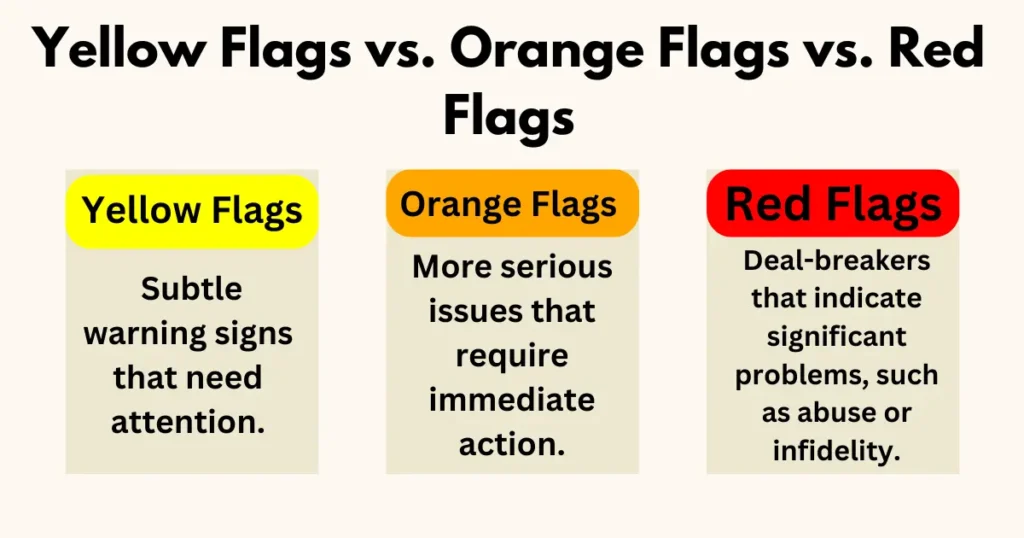Last updated on December 16th, 2025 at 03:15 pm
Have you ever found yourself in a relationship and thought, “Is this normal?” You might notice moments that leave you feeling uneasy, these are often yellow flags. Understanding the yellow flag meaning in relationships is crucial for recognizing subtle warning signs that may need attention. They are not deal-breakers, but they do suggest you should proceed with caution.
As relationship expert Jillian Amodio, LMSW puts it:
“Yellow flags are warning signs that a behavior, tendency, or trait could turn into a larger issue. They are worth discussing and exploring further to ensure a healthy relationship.”
In this article, we will dive deep into the yellow flag meaning in relationships, common signs to watch for, and practical steps to address them. By the end, you’ll have the tools to navigate these warning signs and build a stronger, healthier partnership.
read more: Flags in Dating

Understanding the Yellow Flag Meaning in Relationships?
A yellow flag meaning in relationships refers to a behavior or trait that raises mild concern. It’s not necessarily harmful but could escalate if ignored. Think of it as a “caution” sign—a signal to slow down and evaluate the situation.
Yellow flags are subjective, what bothers one person might not bother another. For example, one partner might see a lack of hobbies as a yellow flag, while another might not mind. The key is to recognize and address these signs early to prevent them from becoming bigger issues.
9 Common Yellow Flags in Relationships
Here are 9 yellow flags to watch out for, along with tips on how to address them:

1. They Want to Spend All Their Time With You
Why It’s a Yellow Flag: It may indicate an unhealthy attachment or lack of independence.
How to Address It: Encourage them to pursue hobbies or spend time with friends. Set boundaries to maintain a healthy balance.
2. They Have No Hobbies or Interests
Why It’s a Yellow Flag: It can lead to emotional dependency or boredom in the relationship.
How to Address It: Suggest activities they might enjoy or explore new hobbies together.
3. They Have No Close Friends
Why It’s a Yellow Flag: It may indicate difficulty maintaining healthy relationships.
How to Address It: Encourage them to build social connections and offer support. For more on building meaningful connections, check out this article on Building Successful Personal Relationships.
4. They are Unwilling to Compromise
Why It’s a Yellow Flag: It suggests a lack of respect or effort.
How to Address It: Have an open conversation about the importance of compromise in a healthy relationship.
5. They Carry a Lot of Debt
Why It’s a Yellow Flag: Financial issues are a leading cause of relationship stress.
How to Address It: Discuss financial goals and create a plan to manage debt together.
6. They Don’t Respect Your Boundaries
Why It’s a Yellow Flag: It shows a lack of respect for your needs and feelings.
How to Address It: Clearly communicate your boundaries and enforce consequences if they are crossed. If you are struggling with boundary-setting, this guide on What is a Platonic Relationship? A Complete Guide might offer some useful insights.
7. They Have a History of Failed Relationships
Why It’s a Yellow Flag: It could signal commitment issues or unhealthy behaviors.
How to Address It: Ask about their past relationships and look for patterns. Sometimes, these patterns stem from self-sabotage. Learn more about this in Self-Sabotage in 2025: Meaning, Causes, and Solutions.
8. They Constantly Hide Information
Why It’s a Yellow Flag: It may indicate dishonesty or communication issues.
How to Address It: Encourage transparency and discuss the importance of trust.
9. They are Either Too Close or Not Close to Their Family
Why It’s a Yellow Flag: It may lead to conflicts or boundary issues.
How to Address It: Discuss family expectations and find a balance for both of you.
Yellow Flags vs. Orange Flags vs. Red Flags
Understanding the difference between these flags is crucial:
Yellow Flags: Subtle warning signs that need attention.
Orange Flags: More serious issues that require immediate action.
Red Flags: Deal-breakers that indicate significant problems, such as abuse or infidelity.
Related read: Top 10 Biggest Red Flags in a Guy to Watch Out For

How to Address Yellow Flags in Your Relationship
- Communicate Openly: Use “I” statements to express your concerns without blame.
- Set Boundaries: Clearly define what behaviors are acceptable.
- Seek Compromise: Find solutions that work for both partners.
- Consider Counseling: A therapist can help you navigate challenges and improve communication.
- Evaluate the Relationship: Decide if the yellow flags are manageable or if they signal deeper issues.
Example
Consider the story of Riya and Tom. Riya noticed that Tom often wanted to spend every weekend together, which made her feel suffocated. Instead of ignoring her feelings, she brought it up with Tom. After discussing their need for personal space, they agreed to have designated “me time” on weekends. This simple conversation helped strengthen their relationship by fostering trust and understanding.
Statistics and Research
According to a 2023 study by the American Psychological Association, couples who communicated openly about their concerns were 60% more likely to have a healthy, long-term relationship. This highlights the importance of addressing yellow flags before they escalate into more serious issues.
Key Takeaways
Yellow flags are subtle warning signs that need attention but aren’t deal-breakers.
Communication is key: Addressing yellow flags early can prevent bigger problems.
Self-awareness is crucial in identifying and addressing concerns.
Relationships require effort: Both partners need to work together to maintain a healthy balance.
Conclusion
Yellow flags are a natural part of any relationship. Recognizing the yellow flag meaning in relationships is essential. By addressing these subtle warning signs early, you can build a stronger, healthier partnership. Remember, open communication, mutual respect, and compromise are the foundations of a successful relationship.
As Dr. Brené Brown says:
“Vulnerability is the birthplace of innovation, creativity, and change.”
Take the time to reflect on your relationship. Are there any yellow flags you have been ignoring? Addressing them today can lead to a happier, more fulfilling partnership tomorrow.

